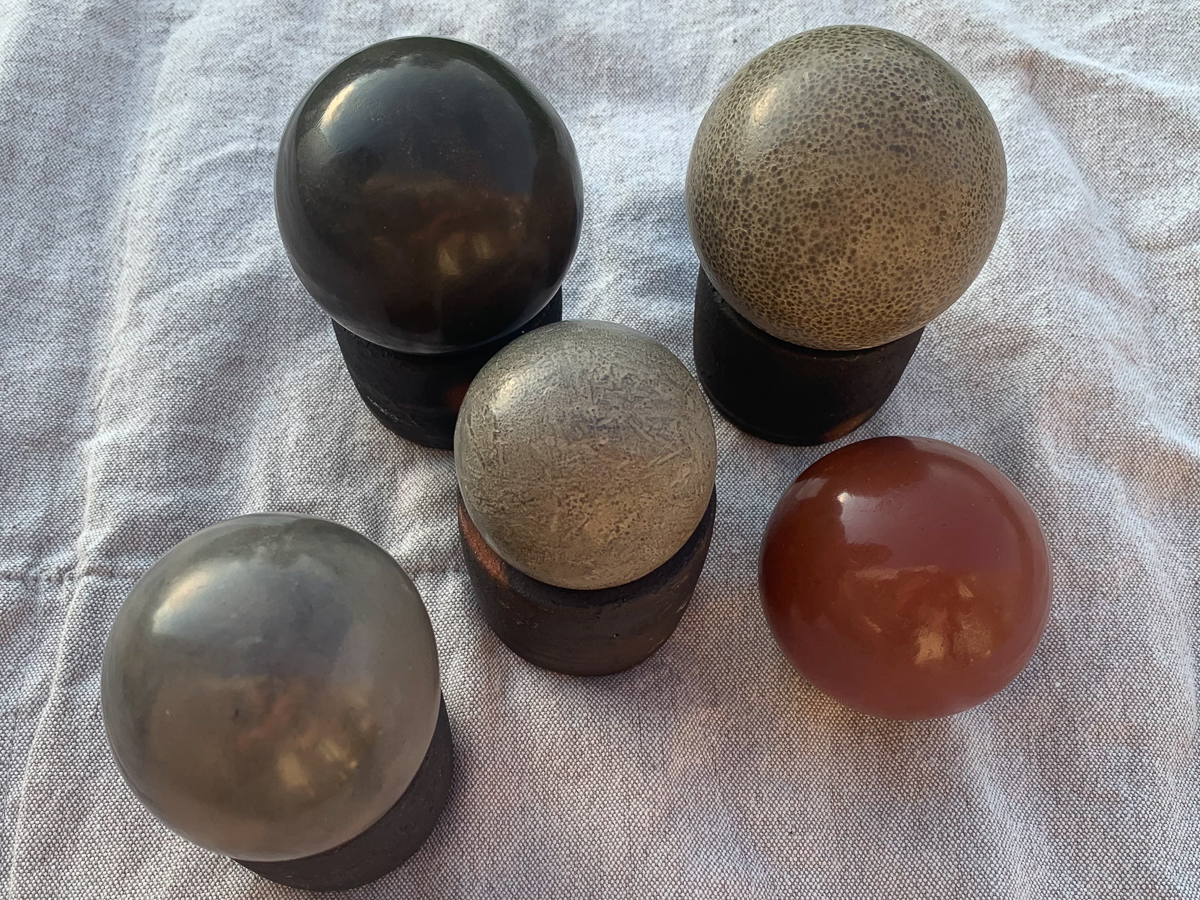
Dorodangos made with a variety of clay and different techniques; by Blissed101 – Own work, CC BY-SA 4.0, https://commons.wikimedia.org/w/index.php?curid=94131324
Jahan Rezakhanlou reveals the wonders of polishing in Japan, Uzbekistan and India.
In Japan, primary school students engage in the unique pastime of producing Hikari Dorodango or polished ceramic balls. Although these simple pieces may look like the result of a typical primary school art and crafts project, it is the process of their creation that distinguishes them.
Students gather mud themselves, slowly roll it into a ball while wetting it, and finally slowly apply layers of fine, dry mud over the surface, in effect “polishing” the mud with their fingers. The end product isn’t put in a kiln or any other contraption, but simply left out to dry on its own, eventually becoming the shiny orb we know as Hikari Dorodango. This process provides a lesson that with enough hard work, patience and attention to detail, something coming from the humblest of origins, even the dirty mud beneath our feet, can be turned into something beautiful and otherworldly.
The process and technique, rather than the end result, illuminates us. The superficial shine tells a deeper story: as the proverb has it, “a gem cannot be polished without friction.” In the present day, one may think of polishing as simply being akin to a finishing touch: to transform something from a raw form into one that is suitable for admiration and consumption. With powerful modern technology available to polish a wide range of items from gemstones to furniture, our ability to polish something has become more and more rudimentary. It is a process that is becoming distanced from humanity.
Samarqand paper polishing
Yet different techniques of polishing around the world are still pursued and show that there is a deeper meaning beyond the mere final result. We can find this in Uzbekistan today. The Meros Paper Mill just outside Samarqand is heralded as a prime example of the revival of the local culture, largely thanks to its careful attention to polishing paper. Since after the dissolution of the Soviet Union, a collective desire arose within the newly-formed Central Asian states to revive national identities independent from the Russian hegemony that had worked to erase them and prevented traditional art forms and practices from thriving. This led to a variety of headline-grabbing cultural developments across the region, from Kazakhstan’s official policies to “spiritually modernise Kazakhstan’s Identity” through heavy investment, to the outright banning of so-called ‘non-Turkmen’ practices (such as ballet and circuses) in Turkmenistan.
Yet the Meros Paper Mill is bringing forward a modest and substantial form of cultural revival for Uzbekistan by reminding the world of the unique polished paper that Samarqand had been famous for centuries ago. From the eighth century onwards, paper from Samarqand was widely admired across Eurasia, particularly in the Islamic world, where calligraphers used feather-pens and therefore need smooth paper, as opposed to the rougher paper that East Asian calligraphers used with their brushes. Water flows from the mountains flows into the mill yielding the power to smash local mulberry bark into a pasty texture. Paper-makers then shape and smash the pulp into a flat and rectangular shape, leave it to dry, and, then, in the Samarqand tradition spend hours polishing the paper with a shell or polished rock. The process is entirely dependent on indigenous material.
“The best paper in the world is made in Samarqand; the water for the paper-mortars all comes from Kan-i-gil, a meadow on the banks of the Kara-su (Blackwater) or Ab-i-rahmat (Water of Mercy).”
Babur, founder of the Mughal Empire
It is another process of endurance and patience, one could never be matched in pure output when compared to the mass-production of typical modern paper and its machine-driven process of mass logging, chemical pulping and packaging on the assembly line. Yet through its creation process within a traditional paper mill, the art of polishing endures in the modern age for the sake of the revival of cultural identity.
Mauryan polish

A highly polished pillar of Ashoka, Lauriya-Araraj.; by Sachin kumar tiwary – Derived from File:ARERAJ INSCRIPTIONS.jpg, CC BY-SA 3.0, https://commons.wikimedia.org/w/index.php?curid=69779319
The process can even extend to being a spiritual matter. In Northern India, the legendary Mauryan king Ashoka went through a spiritual transformation after feeling remorse for his tyrannical ways and converted to Buddhism. During this process, he erected many great pillars, dubbed the Ashoka pillars, inscribed with Buddhist edicts and personal apologies from Ashoka to his people for his former violent ways.
Yet it is their mirror-like texture, the “Mauryan polish”, that makes these pillars truly stand out. These ethereal, stand-alone pillars emerge as in an otherworldly manner as pieces of architecture from an enlightened time. The actual technique of Mauryan polishing is still shrouded in mystery, as it continues to baffle historians today Some suggest that the secret is the use of diamonds: the world’s most valuable gem and hardest material. Perhaps it is a symbol of rejection of the riches that a typical ruler would seek, instead using them to display a spiritual message to his people.
Some Indology professors today even go as far as to avoid the term “polish” and its material connotation and instead use words like “lustre” or “gleam”. Yet by looking at the art of polishing in different instances around the world, we can see that as with any other art form, it is open to interpretation. Understanding the context, the craftsperson behind it and the story they tell, illuminates a whole new shine upon this art form that the physical shine we see, no matter how bright, cannot do justice.
Indeed, the transformation of raw materials to an object of beauty or utility through polishing carries a moral lesson, a kind of stoic aesthetic. Just as the gleam and seeming purity of the diamond is the product of immense pressure and so our characters are shaped through hardship.
And good emerges from what man condemns;
Those stones that mar the hill will polish gems.Shih-ching
About Jahan Rezakhanlou
 Jahan Rezakhanlou is a Swiss-Iranian multidisciplinary artist, musician (and journalist?) currently undertaking his Master of fine arts at RMIT in Melbourne-Naarm, Australia. His research and practice focus on identifying urban and cultural structures and their impacts upon society, having worked with Iranian, Swiss, Hong Kong and Japanese grassroots art collectives both internationally and within Australia. For his Masters, he is examining different egregores within migrant communities in Melbourne-Naarm and how they are sculpted by the urban environment.
Jahan Rezakhanlou is a Swiss-Iranian multidisciplinary artist, musician (and journalist?) currently undertaking his Master of fine arts at RMIT in Melbourne-Naarm, Australia. His research and practice focus on identifying urban and cultural structures and their impacts upon society, having worked with Iranian, Swiss, Hong Kong and Japanese grassroots art collectives both internationally and within Australia. For his Masters, he is examining different egregores within migrant communities in Melbourne-Naarm and how they are sculpted by the urban environment.


